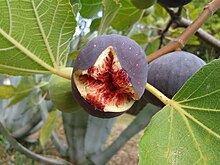 Global Information
Global InformationReproductive coevolution in Ficus information
The genus Ficus is composed of 800 species of vines, shrubs, and trees, defined by their syconiums, the fruit-like vessels that either hold female flowers or pollen on the inside. In addition to being cultivated by humans for thousands of years, Ficus is also known for their reproductive mutualism with the fig wasp.[1]

Fig trees either produce hermaphrodite fruit (caprifigs) or female figs; only the female figs are palatable to humans. In exchange for a safe place for their eggs and larvae, fig wasps help pollinate the ficus by crawling inside the tiny hole in the apex of the fig, called the ostiole, without knowing whether they crawled into a caprifig or a fig. If the female wasp crawls into the caprifig, she can successfully lay her eggs and die. The males hatch first, mate with the females, dig tunnels out of the caprifig, and die. The females, now covered in fig pollen from the caprifig, fly out to begin the cycle again. If the female wasp crawls into a female fig, she will not be able to successfully lay her eggs despite pollinating the fig with pollen from the caprifig she hatched in. The fig will absorb her body and her eggs as the fruit develops.[2]
- ^ Suleman, Nazia; Sait, Steve; Compton, Stephen G. (2015). "Female figs as traps: Their impact on the dynamics of an experimental fig tree-pollinator-parasitoid community" (PDF). Acta Oecologica. 62: 1–9. Bibcode:2015AcO....62....1S. doi:10.1016/j.actao.2014.11.001.
- ^ "Fig." Columbia Electronic Encyclopedia, 6th ed.